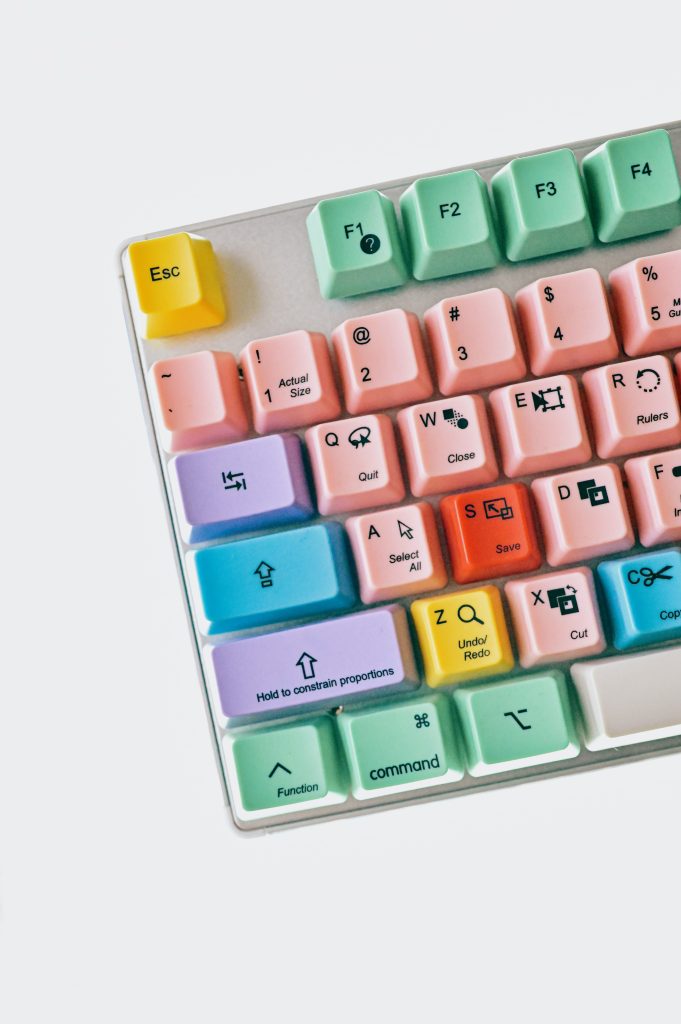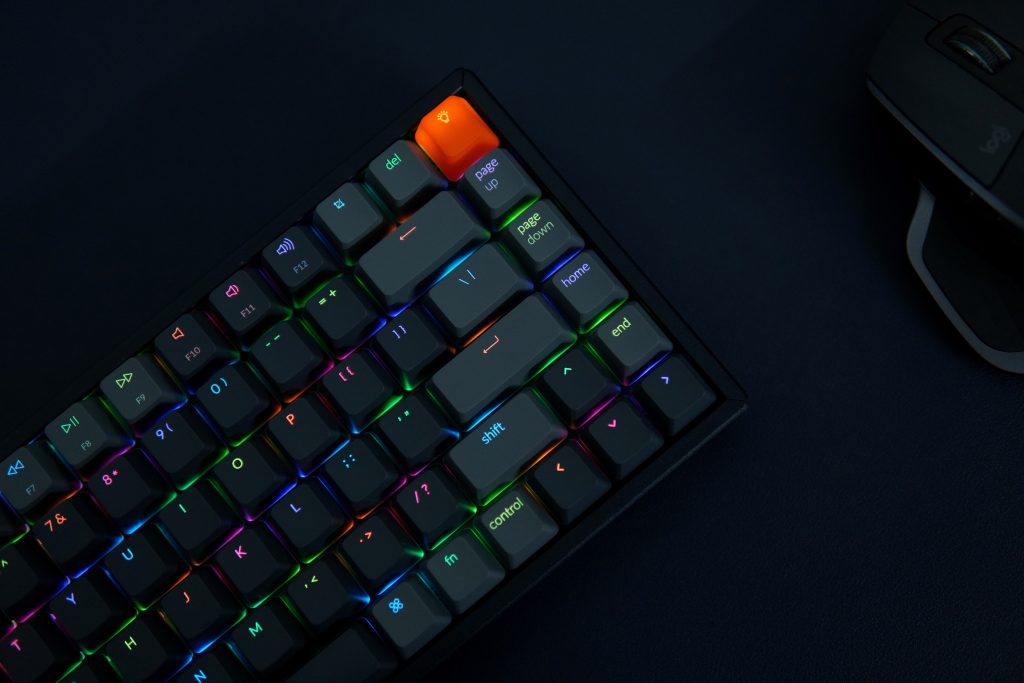Picture this: You’re sitting in front of your laptop, fingers flying over the keyboard as you craft an email or draft a report.
Pause for a moment and look down.
See those keys? Q-W-E-R-T-Y… Ever wondered why they’re arranged in this way?
This layout, so ubiquitous in our lives, was invented by one man. A man of ingenuity, vision, and determination.
His name? Christopher Latham Sholes.

The QWERTY Keyboard Inventor: Meet Christopher Latham Sholes

Born in 1819, Sholes was a journalist by trade, but a tinkerer by nature.
His invention journey started in 1867, long before the age of computers and smartphones, in the era of the telegraph and the manual typewriter.
Typewriters back then were quite different from the ones we’re familiar with.
They used a hunt-and-peck system of keys, which was inefficient and slow.
But Sholes saw an opportunity for innovation.
Invention of the QWERTY Keyboard: A Solution to a Problem
Sholes was not initially interested in improving typing speed.
Instead, he was solving a mechanical issue.
Early typewriters were prone to jams when adjacent keys were hit in quick succession.
Sholes’ “QWERTY” keyboard layout was his ingenious solution to reduce these jams.
By scattering the most commonly used letters across the board, he made sure that the mechanical arms of the typewriter didn’t clash and jam.
And so, QWERTY was born.
QWERTY Keyboard Origins: From Typewriter to Modern Keyboards
The QWERTY design was initially patented in 1868 and first appeared on typewriters produced by Remington – the Remington No. 1, also known as Sholes and Glidden typewriter, in 1873.
Over the years, as typewriters evolved into the computers and keyboards we use today, the QWERTY layout persisted, cementing its place in our daily lives.
Impact of QWERTY Keyboard: From Paper to Digital
Imagine typing this article, or your last email, or that tweet you just shared, on a non-QWERTY keyboard.
Feels strange, right?
The impact of the QWERTY keyboard is more profound than we realize.
It has defined how we interact with technology, from typewriters to computers, and even our smartphones.
It influences how fast we type, how we design software, and even how we learn to type.

QWERTY vs. Dvorak: A Keyboard Controversy
While QWERTY is the standard, it’s not the only keyboard layout in existence.
The Dvorak Simplified Keyboard, invented in the 1930s, promised a more efficient typing experience by placing the most commonly used keys on the ‘home row’ where the fingers rest.
However, despite its alleged efficiency, Dvorak has not replaced QWERTY.
The legacy of Sholes’s invention is so deeply ingrained in our society that switching to a new system is easier said than done.
Future of Keyboards: Is QWERTY Here to Stay?
As we venture further into the digital age, the question arises: Will the QWERTY layout continue to dominate?
Given the rise of touch screens and voice recognition technology, it’s a valid question.
But despite these advances, the QWERTY layout remains firmly in place.
So, next time you type, take a moment to remember Christopher Latham Sholes.
He may not have intended to revolutionize the way we interact with technology, but he certainly did.
His invention is a testament to the power of problem-solving and innovation.
And for that, we owe him our thanks every time our fingers tap a Q, W, E, R, T, or Y.
The Significance of the QWERTY Design
It’s essential to reflect on the reasons why the QWERTY keyboard design has stood the test of time.
Remember, it was born out of a need to prevent mechanical jams.
But it prevailed because it struck a balance.
While it slowed down typing enough to prevent jams, it wasn’t so slow as to be inefficient.
Over time, typists grew accustomed to the layout, increasing their speed and proficiency.
In short, the QWERTY design became embedded in our muscle memory.
Mechanical Keyboard History and the QWERTY Layout
If you’re a fan of mechanical keyboards, you might already appreciate the satisfying ‘clack’ each keypress makes.
But did you know that the first mechanical keyboards also used the QWERTY layout?
This is another testament to Sholes’s enduring invention.
Even with advancements in keyboard technology, the QWERTY layout remains the preferred choice for many typists, programmers, and writers.

Keyboard Design History: More than QWERTY
While we’ve focused on the QWERTY layout, keyboard design history is a fascinating field with more than one story to tell.
For example, there’s the AZERTY keyboard, primarily used in Francophone countries.
There’s also the QWERTZ layout, used in Central Europe.
These layouts, while different from QWERTY, echo the same principle: adapting to the specific needs of their respective languages and typists.
Standard Keyboard Layout: Why Change is Hard
The QWERTY layout’s enduring legacy shows how hard it can be to change a standard once it’s widely adopted.
Despite arguments that other layouts might be more efficient, the cost of retraining billions of people is a formidable barrier.
This inertia, more than anything else, ensures the continuing dominance of the QWERTY layout.
Keyboard Innovations: Beyond QWERTY
While QWERTY remains king, it’s worth noting that keyboard innovations continue.
From ergonomic designs that reduce wrist strain, to virtual keyboards for touchscreens, to adaptable keyboards that users can customize to suit their needs.
In these innovations, we see the spirit of Christopher Latham Sholes alive and well.
We’re continuing to adapt and refine our tools to better serve our needs, just as Sholes did all those years ago.
Understanding QWERTY: A Key to Our Digital World
To truly understand our digital world, one must understand QWERTY.
It’s more than a layout; it’s a key to understanding how we interact with technology.
It’s a reminder that the tools we use every day have deep histories, born out of human ingenuity and the drive to solve problems.
The QWERTY Keyboard Layout: A Language in Itself
The QWERTY keyboard layout is like a language in itself.
We’ve learned it, internalized it, and it shapes the way we communicate in the digital realm.
This ‘language’ of keys has allowed us to bridge communication gaps, work more efficiently, and even create art.
All thanks to Sholes and his ingenious solution to a mechanical problem.
The Typing Technology Development: QWERTY’s Role
The evolution of typing technology is a fascinating field of study.
From the early days of typewriters to today’s touchscreens and voice-to-text technology, typing has changed dramatically.
But through all these developments, one thing has remained constant – the QWERTY keyboard layout.
It’s like a steadfast anchor in the rapidly shifting seas of technology.

Remington Typewriter and QWERTY: A Successful Collaboration
It’s worth mentioning the role of the Remington Company, the first to incorporate the QWERTY layout into their typewriters.
By choosing to adopt Sholes’s design, they played a significant part in popularizing the QWERTY layout.
And the rest, as they say, is history.
QWERTY Keyboard Design: A Testament to Problem-Solving
In conclusion, the QWERTY keyboard design is more than just a random arrangement of letters.
It’s a testament to problem-solving, a symbol of innovation, and a reminder of how a single invention can shape our world in profound ways.
In the end, the story of the QWERTY keyboard isn’t just about a machine.
It’s about the man behind the machine – Christopher Latham Sholes – and his ability to turn problems into solutions, solutions into standards, and standards into a legacy that continues to influence our digital world.
The next time your fingers dance across the keyboard, take a moment to appreciate the QWERTY layout for what it truly is – a historical marvel, a product of innovation, and a key player in our daily lives.
Behind every key press, every word typed, and every message sent, is the genius of one man who dared to think differently.
So, here’s to Christopher Latham Sholes, the genius behind the keys. May his story continue to inspire us in our journey through the ever-evolving landscape of technology.
Conclusion:
In our exploration of the QWERTY keyboard, we’ve delved into the brilliance of Christopher Latham Sholes, the creator of a design that elegantly solved a challenging problem. We’ve admired the enduring legacy of the QWERTY layout, which has stood the test of time, showcasing adaptability in the rapidly evolving world of technology.
From the mechanical precision of typewriters to the sleek modern keyboards, the QWERTY layout has been a constant. Whether prioritizing tactile feedback, embracing ergonomic comfort, seeking wireless freedom, or cherishing customizable setups, the QWERTY layout has proven its versatility.
Its story is a testament to human ingenuity, a journey of constant adaptation, innovation, and endurance. Every press of a key, every word typed, and every message sent is a small tribute to Sholes and his timeless creation.
So, as you engage with the QWERTY layout, remember: each keystroke is a part of a larger narrative of progress and human ingenuity.
Read More: The Ultimate Guide to Why Mechanical Keyboards Are a Better Choice

Experience is what matters at the end!!
Hi! This is Jacob Jay – founder of Keyboardgear.com! From childhood to adulthood, I’ve always remained passionate about IT, and the revolution in this industry, especially gaming on the PC can’t go out of my way. Since I’m an enthusiastic gamer, and I love to experience various gaming accessories, particularly mechanical keyboards, that really boost my gaming adventure manifolds. So, my nerve cells hit me to transfer my experiences into word form and share with others to identify the ideal keyboards perfectly fit for their gaming modes.
I know very well how hard it is to find the high-quality items available on the internet that ought to be exactly the same as seen as on the screen. But the counterfeiters have ruined the user’s trust. As I have passed all such situations, I’m obliged to deliver the genuinity and express the same as what I am saying.
So, now, I’m working on the mission to provide very helpful and frankly but trustworthy reviews and guides about various mechanical keyboards, mouses, and other gaming accessories as per my personal experiences and sound knowledge.
